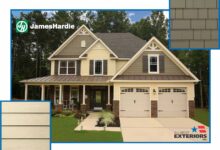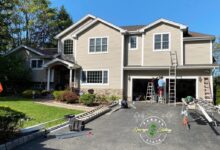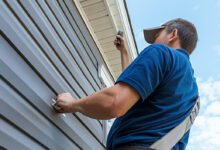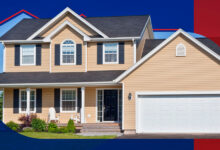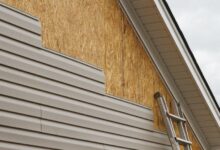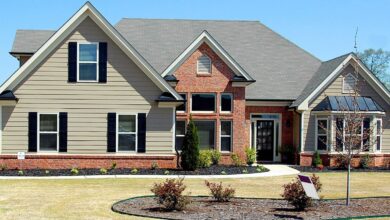Replacement Siding: A Comprehensive Guide
Replacement siding offers a transformative opportunity to enhance your home’s curb appeal and protect it from the elements. This guide delves into the diverse world of siding materials, from classic wood to modern engineered options, comparing durability, maintenance needs, and costs. We’ll explore the installation process, crucial cost factors, and essential maintenance practices to ensure your siding investment lasts for years to come. Understanding the environmental impact and warranty considerations will complete your informed decision-making process.
Choosing the right siding is a significant investment, impacting both the aesthetic and functional aspects of your home. This guide provides a detailed overview of various siding materials, their properties, and installation processes, enabling you to make an informed choice that aligns with your budget, style preferences, and environmental concerns. We will also explore the crucial aspects of maintenance and repair to ensure the longevity of your siding.
Types of Replacement Siding
Choosing the right replacement siding can significantly impact your home’s curb appeal, energy efficiency, and long-term value. Understanding the various options available, along with their respective pros and cons, is crucial for making an informed decision. This section will explore the most common siding materials, comparing their durability, maintenance needs, and cost.
Siding Material Comparisons
The following table summarizes key characteristics of popular siding materials. Note that costs can vary significantly based on factors like material quality, installation complexity, and regional pricing. Durability is also influenced by climate and proper installation.
| Material | Durability | Maintenance | Cost (Relative) |
|---|---|---|---|
| Vinyl | Moderate to high; resistant to rot, insects, and moisture. Can be susceptible to damage from impact. Lifespan typically 20-40 years. | Low; typically requires only occasional cleaning. | Low to moderate |
| Fiber Cement | High; very durable, resistant to fire, rot, insects, and impact. Lifespan can exceed 50 years. | Moderate; requires periodic painting or staining to maintain appearance. | Moderate to high |
| Wood | Moderate; susceptible to rot, insects, and moisture damage if not properly treated and maintained. Lifespan varies greatly depending on wood type and maintenance. | High; requires regular painting, staining, and potential repairs. | Moderate to high |
| Metal (Aluminum, Steel, Zinc) | High; very durable, resistant to fire, rot, insects, and impact. Can dent or scratch. Lifespan can exceed 50 years. | Low; typically requires only occasional cleaning. | Moderate to high |
| Engineered Wood | Moderate to high; offers improved durability and moisture resistance compared to traditional wood. Lifespan typically 20-30 years. | Moderate; requires periodic painting or staining. | Moderate |
Vinyl Siding
Vinyl siding is a popular choice due to its affordability and low maintenance. Its resistance to rot, insects, and moisture makes it a practical option in many climates. However, it can be susceptible to damage from impact, and extreme temperature fluctuations can cause expansion and contraction, potentially leading to cracking or warping. Proper installation is crucial to prevent these issues. A well-maintained vinyl siding system can last for 20-40 years.
Fiber Cement Siding
Fiber cement siding offers superior durability compared to vinyl, boasting excellent resistance to fire, rot, insects, and impact. Its longevity, often exceeding 50 years, makes it a cost-effective choice in the long run despite a higher initial investment. However, it requires periodic painting or staining to maintain its appearance and is heavier than vinyl, potentially increasing installation costs.
Wood Siding
Wood siding offers a classic, aesthetically pleasing look, but requires significant maintenance to prevent rot, insect infestation, and moisture damage. Regular painting or staining, along with potential repairs, are necessary to maintain its appearance and structural integrity. The lifespan of wood siding varies greatly depending on the type of wood, the quality of the finish, and the climate.
Metal Siding
Metal siding, including aluminum, steel, and zinc options, provides exceptional durability and resistance to fire, rot, insects, and impact. It’s a low-maintenance option that typically requires only occasional cleaning. However, metal siding can dent or scratch, and its appearance might not appeal to everyone. The high initial cost is often offset by its extremely long lifespan, often exceeding 50 years.
Engineered Wood Siding
Engineered wood siding combines the aesthetic appeal of natural wood with enhanced durability and moisture resistance. It offers a good balance between cost and performance, making it a viable alternative to traditional wood or more expensive options like fiber cement. However, it still requires periodic painting or staining to maintain its appearance. The lifespan typically ranges from 20 to 30 years.
Installation Process of Replacement Siding
Replacing your home’s siding is a significant undertaking, requiring careful planning and execution. The process, while seemingly straightforward, involves several crucial steps to ensure a long-lasting, aesthetically pleasing, and weather-resistant exterior. Proper preparation and attention to detail are key to a successful installation.
The installation process for replacement siding typically involves several stages, from initial preparation to final cleanup. Each stage requires specific tools and expertise, and adhering to safety protocols is paramount throughout the project. Understanding these steps allows homeowners to better manage expectations and communicate effectively with contractors.
Site Preparation and Measurement
Before any siding is installed, the existing siding must be removed. This involves carefully detaching each piece, taking care not to damage underlying sheathing. Any damaged or rotten wood should be replaced at this stage. Accurate measurements of the house’s exterior are crucial for determining the quantity of new siding needed. This includes accounting for windows, doors, and other architectural features. Tools required for this stage include pry bars, hammers, safety glasses, and measuring tapes.
Sheathing Inspection and Repair
Once the old siding is removed, a thorough inspection of the underlying sheathing is necessary. This involves checking for any damage, rot, or insect infestation. Any damaged areas should be repaired or replaced before installing the new siding. This step ensures a solid foundation for the new siding and prevents future problems. Necessary tools include hammers, saws, nails, and possibly a moisture meter to detect rot.
Installation of New Siding
The installation of the new siding begins with the installation of starter strips at the bottom of the wall. Subsequent siding panels are then installed, overlapping each other and secured with nails or screws. Proper alignment and spacing are crucial for a professional look. The type of siding will dictate the specific installation method, but generally involves using a nail gun, level, and measuring tape for precise placement. Different siding materials might require specialized tools or fasteners. For example, vinyl siding often uses a special siding nail designed to allow for expansion and contraction.
Caulking and Finishing
After all siding panels are installed, any gaps or seams should be caulked to prevent water penetration. Caulk provides a waterproof seal, protecting the house from moisture damage. Final touches might include installing trim pieces, flashing around windows and doors, and cleaning up any debris. Caulk guns, various types of caulking, and putty knives are necessary for this stage.
Safety Precautions During Installation
It is crucial to prioritize safety throughout the entire siding installation process. The following precautions should be observed:
- Always wear appropriate safety gear, including safety glasses, gloves, and work boots.
- Use caution when working at heights; utilize scaffolding or ladders as needed and ensure they are properly secured.
- Be mindful of power lines and other potential hazards.
- Properly dispose of all waste materials.
- Follow the manufacturer’s instructions for the specific type of siding being installed.
- Never work alone; always have a spotter or assistant when working at heights or with power tools.
Cost Factors Affecting Replacement Siding Projects
The total cost of a replacement siding project can vary significantly depending on several interconnected factors. Understanding these factors allows homeowners to budget effectively and make informed decisions about their siding choices. Failing to account for these variables can lead to unexpected expenses and project delays.
Several key elements contribute to the final price. Material selection plays a crucial role, with different materials ranging widely in cost per square foot. Labor costs, heavily influenced by the project’s complexity and the prevailing local wages, are another significant factor. The size of the house directly impacts the quantity of materials and labor needed. Finally, geographical location affects both material availability and labor rates, leading to regional price variations.
Siding Material Costs
Different siding materials come with different price tags. Vinyl siding, a popular choice for its affordability and low maintenance, generally falls within a lower price range. Fiber cement siding, known for its durability and fire resistance, commands a higher price. Wood siding, offering a classic aesthetic, can vary widely in cost depending on the type of wood used. Metal siding, increasingly popular for its longevity and sustainability, sits at a mid-to-high price point. These price differences stem from the raw materials, manufacturing processes, and installation requirements associated with each material. The cost per square foot is directly proportional to the complexity of manufacturing and installation. For instance, intricate designs or custom colors will often add to the cost of any material.
Labor Costs and Project Complexity
Labor costs are a significant portion of the overall project expense. The complexity of the job greatly influences the number of labor hours required. A simple, straightforward installation on a single-story house will typically require fewer labor hours than a complex project involving multiple stories, intricate trim work, or extensive repairs to underlying sheathing. Local labor rates also play a significant role; areas with a high cost of living tend to have higher labor rates, impacting the final project cost. For example, a project in a major metropolitan area might cost considerably more than a similar project in a rural setting due to differences in labor rates and material transport costs.
House Size and Project Scope
The size of the house directly impacts the amount of siding material needed. A larger house obviously requires more materials, increasing the overall material cost. The project scope also matters. Removing existing siding, repairing underlying damage, and installing new flashing and trim can significantly add to the labor hours and thus the total cost. For instance, a 2,000 square foot home will require significantly more siding and labor than a 1,000 square foot home, resulting in a proportionally higher overall cost. Adding features like custom trim or intricate detailing will also increase the total cost.
Geographic Location and Market Conditions
Regional differences in material availability and labor costs significantly impact the final price. Areas with limited access to certain materials may experience higher costs due to transportation and handling. Similarly, labor markets with high demand and low supply can drive up labor rates. Supply chain disruptions, particularly relevant in recent years, can also lead to material price fluctuations and potential project delays. For example, a coastal area prone to hurricanes might experience higher demand for impact-resistant siding, leading to increased material costs compared to inland areas.
Estimated Cost Ranges
| Siding Material | Small House (1000 sq ft) | Medium House (1500 sq ft) | Large House (2500 sq ft) |
|---|---|---|---|
| Vinyl | $5,000 – $10,000 | $7,500 – $15,000 | $12,500 – $25,000 |
| Fiber Cement | $10,000 – $20,000 | $15,000 – $30,000 | $25,000 – $50,000 |
| Wood | $15,000 – $30,000 | $22,500 – $45,000 | $37,500 – $75,000 |
| Metal | $12,000 – $24,000 | $18,000 – $36,000 | $30,000 – $60,000 |
Maintenance and Repair of Replacement Siding
Proper maintenance is key to extending the life and beauty of your new siding. Regular cleaning and prompt attention to minor repairs can prevent significant damage and costly replacements down the line. Different siding materials require slightly different care, but the general principles of cleanliness and timely repairs apply across the board.
Maintaining Different Siding Materials
The longevity of your siding depends heavily on the type of material and how well it’s maintained. Regular cleaning removes dirt, grime, and debris that can cause staining and damage. For example, pressure washing is effective for vinyl and fiber cement, but should be done carefully to avoid damaging the surface. Wood siding, on the other hand, requires more gentle cleaning methods, possibly using a soft brush and mild detergent. Aluminum siding is relatively low-maintenance but still benefits from periodic washing. Always refer to the manufacturer’s recommendations for your specific siding type.
Common Siding Problems and Their Solutions
Several common issues can affect replacement siding. Algae and mildew growth are frequent problems, especially in humid climates. Regular cleaning with a solution of bleach and water (following safety precautions) can usually resolve this. Cracks and holes are another concern, often caused by impact damage or extreme weather. Smaller cracks might be sealed with caulk, while larger holes may require patching with matching material or professional repair. Loose or damaged siding panels should be addressed promptly to prevent further damage and water intrusion. Ignoring these issues can lead to more extensive and costly repairs later.
Repairing Minor Damage to Various Siding Types
Minor repairs are often manageable with DIY methods. For example, small holes in vinyl siding can be filled with vinyl caulk designed for exterior use. Similarly, minor scratches on aluminum siding can often be buffed out with a metal polish. Wood siding repairs may involve replacing damaged planks or filling in cracks with wood filler, followed by painting or staining to match the existing finish. Fiber cement siding repairs typically involve patching with matching cement and painting. However, significant damage or extensive repairs are best left to professionals to ensure proper installation and a lasting fix. Always consult your siding manufacturer’s instructions for specific repair recommendations.
Choosing the Right Siding for Your Home
Selecting the right siding for your home is a crucial decision impacting both aesthetics and longevity. The ideal choice depends on a complex interplay of factors, ensuring a harmonious blend of style, practicality, and budget considerations. Careful consideration of climate, architectural style, and personal preferences is paramount in achieving a successful outcome.
Climate Considerations in Siding Selection
Climate significantly influences siding material durability and lifespan. Homes in areas with harsh winters, for example, benefit from materials resistant to ice and snow damage, such as vinyl or fiber cement. Conversely, regions with intense sun exposure might require siding with superior UV resistance, like engineered wood or certain types of vinyl. Coastal areas demand siding that can withstand salt spray and moisture, making materials like fiber cement or aluminum suitable choices. Ignoring these climate-specific needs can lead to premature deterioration and costly repairs.
Siding Material Suitability for Architectural Styles
Different siding materials complement various architectural styles. For instance, clapboard siding, with its traditional horizontal profile, is a classic choice for Colonial or Victorian homes, lending an authentic historical feel. Modern homes often pair well with sleek, contemporary materials like metal panels or smooth-surface fiber cement. A rustic farmhouse style might be enhanced by the natural texture of wood siding, while a Craftsman-style home could benefit from the vertical lines of board and batten siding. Selecting siding that complements the home’s architecture enhances its overall appeal and maintains its design integrity.
Aesthetic Appeal of Various Siding Options
A visual comparison of siding options reveals significant aesthetic differences.
| Siding Type | Appearance Description |
|---|---|
| Vinyl Siding | Vinyl siding offers a wide array of colors and textures, mimicking the look of wood, stone, or brick. It often features a smooth or slightly textured surface with subtle color variations. Patterns can range from simple horizontal lines to more intricate designs. While durable, it can lack the depth and richness of natural materials. |
| Fiber Cement Siding | Fiber cement siding provides a more natural look and feel, closely resembling wood clapboard or shingle styles. It offers a variety of textures, from smooth to deeply textured, and comes in a wide range of colors. The material’s inherent durability allows for greater variation in color and texture than vinyl. |
| Wood Siding | Wood siding offers unmatched natural beauty and warmth. The texture can vary widely depending on the type of wood and the finish applied, from smooth cedar to rough-hewn pine. Color variations are inherent to the wood itself, offering a unique character. However, wood requires regular maintenance to prevent rot and insect damage. |
| Metal Siding | Metal siding, often aluminum or steel, offers a clean, modern aesthetic. It’s available in a variety of colors and finishes, including smooth, textured, or embossed. It can mimic the look of other materials, such as wood or stone, but often has a distinctly modern feel. Metal siding is known for its durability and low maintenance. |
Environmental Impact of Replacement Siding
Choosing replacement siding involves more than just aesthetics and cost; it carries significant environmental implications. The manufacturing process, material lifespan, and end-of-life recyclability of different siding options all contribute to their overall environmental footprint. Understanding these factors is crucial for making informed and sustainable choices.
The environmental impact of siding materials varies considerably. Factors such as energy consumption during manufacturing, transportation distances, and the embodied carbon within the materials themselves all play a role. Furthermore, the durability and longevity of the siding directly influence its long-term environmental impact, as a longer-lasting product reduces the need for frequent replacements.
Manufacturing Processes and Embodied Carbon
The manufacturing process for various siding materials significantly impacts their carbon footprint. For instance, vinyl siding, a popular choice due to its affordability, often relies on petroleum-based plastics, resulting in higher greenhouse gas emissions during production. Conversely, fiber cement siding, while initially more energy-intensive to produce, boasts a longer lifespan, potentially offsetting its higher upfront carbon footprint over its service life. Wood siding, depending on its source and treatment, can range in environmental impact. Sustainably harvested and responsibly treated wood has a comparatively lower carbon footprint than wood from unsustainable sources. Metal sidings, such as aluminum and steel, also have varying impacts based on the energy used in their production and the sourcing of raw materials. For example, recycled aluminum siding boasts a significantly lower carbon footprint than siding made from newly mined aluminum.
Lifespan and Durability
The lifespan of siding directly correlates to its environmental impact. A longer-lasting siding material reduces the frequency of replacements, thereby minimizing the environmental burden associated with manufacturing, transportation, and disposal. Vinyl siding, while relatively inexpensive, often has a shorter lifespan compared to fiber cement or metal siding. This shorter lifespan necessitates more frequent replacements, leading to increased environmental impact over the long term. Conversely, materials like fiber cement and metal siding, known for their durability and resistance to weather damage, offer a longer service life, resulting in a reduced overall environmental footprint. The longevity of wood siding is highly dependent on the species of wood, the quality of the installation, and the appropriate maintenance practices.
Recyclability and End-of-Life Management
The recyclability of siding materials is another critical factor to consider. Some materials, such as vinyl siding, have limited recyclability options, often ending up in landfills. Other materials, like aluminum siding, are highly recyclable and can be reused in various applications. Fiber cement siding is generally not recyclable in the same way as aluminum, but its components can sometimes be salvaged and reused in other construction projects. Wood siding, depending on its condition, may be suitable for reuse or repurposing, offering a more sustainable end-of-life scenario compared to non-recyclable options. Responsible disposal practices are crucial for minimizing the environmental impact of any siding material at the end of its life cycle. Proper disposal helps prevent landfill accumulation and reduces the risk of environmental contamination.
Warranty and Guarantees for Replacement Siding
Understanding the warranty and guarantees associated with your replacement siding is crucial for protecting your investment and ensuring long-term satisfaction. A comprehensive warranty provides recourse should defects arise in the materials or workmanship, safeguarding you from potentially costly repairs or replacements down the line. This section details the importance of reviewing warranty information and common terms found within these documents.
Warranties and guarantees offered by siding manufacturers and installers vary significantly. It’s vital to carefully read and understand the specifics of each warranty before making a purchase decision. These documents typically outline the duration of coverage, the types of defects covered, and the procedures for filing a claim. Differences in coverage can significantly impact the overall value proposition of different siding options.
Common Terms and Conditions in Siding Warranties
Siding warranties generally cover defects in materials and workmanship. However, the specific terms and conditions can differ substantially. Common elements include the warranty period (often ranging from 10 to 50 years, depending on the material and manufacturer), limitations on coverage (such as excluding damage caused by weather events or improper installation), and the process for submitting a claim (often requiring detailed documentation and potentially inspections). Exclusions frequently include damage caused by acts of God, improper maintenance, or vandalism. Furthermore, some warranties are transferable to subsequent homeowners, while others are not. Understanding these nuances is key to making an informed decision.
Warranty Comparison Table
The following table offers a simplified comparison of warranty offerings from three hypothetical siding manufacturers. Note that these are illustrative examples and actual warranties may differ. Always consult the manufacturer’s official documentation for the most accurate and up-to-date information.
| Manufacturer | Material | Warranty Period (Years) | Coverage | Transferability |
|---|---|---|---|---|
| Everlast Siding | Vinyl | 30 | Materials and workmanship against defects | Yes |
| DuraGuard Exteriors | Fiber Cement | 50 | Materials and workmanship; excludes damage from extreme weather | No |
| Classic Cladding | Wood | 15 | Materials only; excludes rot and insect damage | Yes, with registration |
Closure
Ultimately, selecting replacement siding involves careful consideration of numerous factors. From the initial assessment of your home’s style and climate to the detailed comparison of materials, costs, and maintenance requirements, making an informed decision ensures a beautiful and durable exterior for years to come. By understanding the various options and their implications, you can confidently transform your home’s exterior while making a responsible and sustainable choice.

